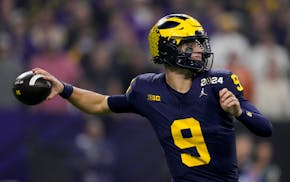On Sept. 1, the Vikings not only found themselves without a starting quarterback, they were the only team in the NFC North without a quarterback who at some point in his career was considered a franchise quarterback.
When Teddy Bridgewater injured his knee, the Vikings were left with Shaun Hill and an uninspiring list of likely trade targets. They were in danger of falling far behind the competition at the most important position in football.
The Packers featured Aaron Rodgers, one of the great quarterbacks of his era. The Lions had watched Matthew Stafford, a former No. 1 pick, develop into an accurate and often inspirational quick-pass artist under offensive coordinator Jim Bob Cooter. The Bears relied on Jay Cutler, a remarkable talent in the process of disappointing a second franchise that mistakenly thought of him as a saviour.
The pecking order was clear: The Packers held the advantage, the Lions had reason for hope, the Bears were hoping for a late-career epiphany and the Vikings were desperate to find someone competent.
A couple of days later, the Vikings traded for Sam Bradford. As he prepares to face Stafford today for first place in the NFC North, the division's quarterback ranking has been transformed.
Rodgers peaked in terms of efficiency and production in 2011. He had his last season of excellence in 2014. Since the start of the 2015 season, he has declined statistically and the Packers have become vulnerable. They are 4-6 this season with a team built around an intricate passing offense in which Rodgers seems to lack confidence.
He ranks 13th in passer rating this season and 19th in completion percentage. The eye test confirms the statistical decline: Rodgers is playing with more desperation than arrogance, and more often than before fails to see open receivers.
Stafford has become the most statistically proficient passer in the division. He ranks fifth in the NFL in passer rating and completion percentage. His team has trailed in all 10 fourth quarters this season and yet is 6-4. He lost Calvin Johnson and added Cooter and became a better quarterback for it.
Cutler's talent always has been offset by recklessness. He has played poorly and might not play again this season because of a shoulder injury.
Bradford came to the Vikings with a reputation for underachieving and brittleness. He had played only with struggling teams. If you judge quarterbacks only by won-loss records, which would be a terrible way to go about it, you would see a quarterback who is an unremarkable 5-4 and was partly responsible for a four-game losing streak.
We know a lot more about Bradford now than we did Sept. 3. He had to adapt to a new offense on the fly. He is playing behind one of the worst, if not the worst, offensive lines in the NFL. He has no running game on which to rely. He has no established star receivers, although Stefon Diggs could become one.
Under the most difficult circumstances you could invent, Bradford has proved durable and accurate. He ranks third in the NFL in completion percentage and eighth in passer rating. He has withstood brutal hits and refused to leave the field.
Bradford also passes the eye test. If a receiver is open, Bradford usually hits him immediately. He has thrown with velocity and touch.
Who's the best quarterback in the division?
Taking the long view, the answer has to be Rodgers. His body of work is undeniable.
Who's the best quarterback in the division this year?
Stafford and Bradford were long considered disappointments. This season, they have taken Rodgers' championship belt. They'll spend today tugging at each end.
Jim Souhan's podcast can be heard at MalePatternPodcasts.com. On Twitter:
@SouhanStrib. • jsouhan@startribune.com

Souhan: Wolves fans made Game 1 special. Now bring on Game 2.

Souhan: Should Vikings even consider McCarthy in NFL draft?

Souhan: NAW erases Suns' lead, Game 1 advantage with big performance

Souhan: This is KAT's chance to prove Flip Saunders was right

